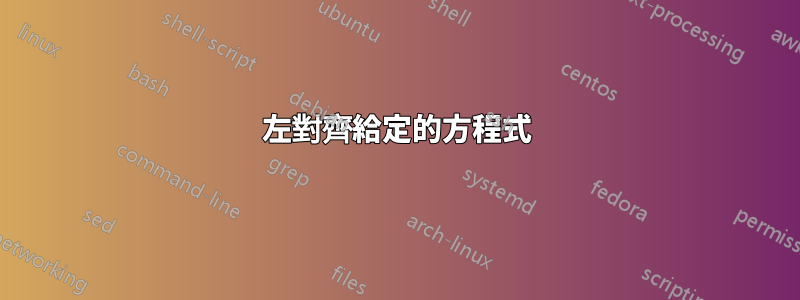
問題:我如何證明(在左側)給定方程式的合理性?
微量元素
\documentclass[12pt,a4paper]{article}
\usepackage[utf8]{inputenc}
\usepackage[T1]{fontenc}
\usepackage[width=1.00cm, height=1.00cm, left=1.00cm, right=1.00cm, top=1.00cm, bottom=1.00cm]{geometry}
\usepackage{amssymb}
\usepackage{mathtools}
\usepackage{amsthm}
\begin{document}
\begin{equation}
\begin{split}
\dfrac{\partial T}{\partial t}+\left(u\,\frac{\partial T}{\partial x} + v\,\frac{\partial T}{\partial y}\right)
&= \left(\dfrac{k_{2}}{\rho\,c_{p}}\right)\,\dfrac{\partial^2 T}{\partial y^2}+\left(\dfrac{\mu+\kappa}{\rho\,c_{p}}\right)\,\left(\dfrac{\partial u}{\partial y}\right)^2
+ \left(\dfrac{\sigma B_{0}^2}{\rho\,c_{p}}\right)\;u^2 \\[1ex]
&\qquad\qquad\quad\quad\quad\qquad\qquad -\dfrac{1}{\rho\,c_{p}}\;\dfrac{\partial q_{r}}{\partial y} +q'''
\end{split}
\end{equation}
\end{document}
答案1
不清楚為什麼要推一左邊距的方程式:要嘛沒有,要嘛全部。後一個選擇是透過指定fleqn文檔類選項來獲得的。
無論如何,我(使用較窄的文字寬度)提供了幾種您可以做的方法。
請注意輸入的簡化和幾個標記的省略\,(以及錯誤的\;)。在兩種情況下,我甚至添加了\!:when\right)後面緊跟著\left(指數中的 and 。
偏導數工具使輸入更具可讀性。
\documentclass[12pt,a4paper]{article}
\usepackage{mathtools}
\usepackage{amssymb}
\usepackage{amsthm}
\usepackage{showframe}
\newcommand{\pder}[2]{\frac{\partial #1}{\partial #2}}
\begin{document}
Just the last term on the next line
\begin{equation}
\begin{aligned}
\pder{T}{t}+\left(u\,\pder{T}{x} + v\,\pder{T}{y}\right)
=
\left(\frac{k_{2}}{\rho c_{p}}\right)\pder{^2 T}{y^2}
+
\left(\frac{\mu+\kappa}{\rho c_{p}}\right)\!\left(\pder{u}{y}\right)^{\!2}
+
\left(\frac{\sigma B_{0}^2}{\rho c_{p}}\right) u^2
\\[1ex]
{}-
\dfrac{1}{\rho\,c_{p}}\,\pder{q_{r}}{y}+q'''
\end{aligned}
\end{equation}
Just the last term in the next line, but pushed a bit to the left
\begin{equation}
\begin{aligned}
\pder{T}{t}+\left(u\,\pder{T}{x} + v\,\pder{T}{y}\right)
=
\left(\frac{k_{2}}{\rho c_{p}}\right)\pder{^2 T}{y^2}
+
\left(\frac{\mu+\kappa}{\rho c_{p}}\right)\!\left(\pder{u}{y}\right)^{\!2}
+
\left(\frac{\sigma B_{0}^2}{\rho c_{p}}\right) u^2
\\[1ex]
{}-
\dfrac{1}{\rho\,c_{p}}\,\pder{q_{r}}{y}+q''' \qquad
\end{aligned}
\end{equation}
Two terms in the next line
\begin{equation}
\begin{aligned}
\pder{T}{t}+\left(u\,\pder{T}{x} + v\,\pder{T}{y}\right)
=
\left(\frac{k_{2}}{\rho c_{p}}\right)\pder{^2 T}{y^2}
+
\left(\frac{\mu+\kappa}{\rho c_{p}}\right)\!\left(\pder{u}{y}\right)^{\!2}
\\[1ex]
{}+
\left(\frac{\sigma B_{0}^2}{\rho c_{p}}\right) u^2
-
\dfrac{1}{\rho\,c_{p}}\,\pder{q_{r}}{y}+q'''
\end{aligned}
\end{equation}
A more conventional set up
\begin{multline}
\pder{T}{t}+\left(u\,\pder{T}{x} + v\,\pder{T}{y}\right)
=
\left(\frac{k_{2}}{\rho c_{p}}\right)\pder{^2 T}{y^2}
+
\left(\frac{\mu+\kappa}{\rho c_{p}}\right)\!\left(\pder{u}{y}\right)^{\!2}
\\[1ex]
+
\left(\frac{\sigma B_{0}^2}{\rho c_{p}}\right) u^2
-
\dfrac{1}{\rho\,c_{p}}\,\pder{q_{r}}{y}+q'''
\end{multline}
A more conventional set up with just one term on the next line
\begin{multline}
\pder{T}{t}+\left(u\,\pder{T}{x} + v\,\pder{T}{y}\right)
=
\left(\frac{k_{2}}{\rho c_{p}}\right)\pder{^2 T}{y^2}
+
\left(\frac{\mu+\kappa}{\rho c_{p}}\right)\!\left(\pder{u}{y}\right)^{\!2}
+
\left(\frac{\sigma B_{0}^2}{\rho c_{p}}\right) u^2
\\[1ex]
-
\dfrac{1}{\rho\,c_{p}}\,\pder{q_{r}}{y}+q'''
\end{multline}
\end{document}
答案2
鑑於使用的邊距相當窄,我看不出將方程式分成兩行的好論點。要將此方程式(以及所有其他方程式)向左對齊,我建議您指定fleqn為文檔類別選項。哦,我還會去掉不必要的高括號。
\documentclass[12pt,a4paper,fleqn]{article}
%%\usepackage[utf8]{inputenc} % that's the default nowadays
\usepackage[T1]{fontenc}
\usepackage[margin=1cm]{geometry}
\usepackage{amssymb,mathtools,amsthm}
\begin{document}
\begin{equation}
\frac{\partial T}{\partial t}
+\left(u\,\frac{\partial T}{\partial x}
+ v\,\frac{\partial T}{\partial y}\right)
= \frac{k_{2}}{\rho\,c_{p}}\, \frac{\partial^2 T}{\partial y^2}
+\frac{\mu+\kappa}{\rho\,c_{p}}
\left(\frac{\partial u}{\partial y}\right)^{\!\!2}
+\frac{\sigma B_{0}^2}{\rho\,c_{p}}\,u^2
-\frac{1}{\rho\,c_{p}}\,\frac{\partial q_{r}}{\partial y}
+q'''
\end{equation}
\end{document}




